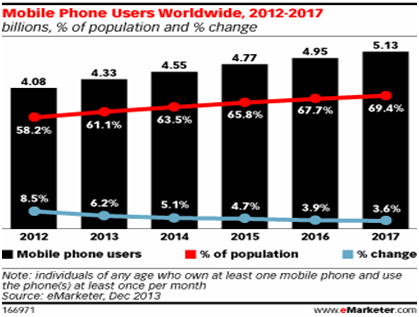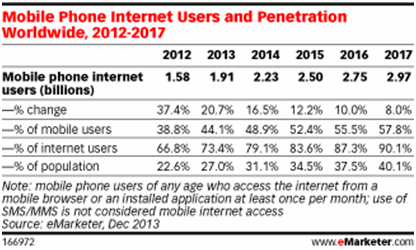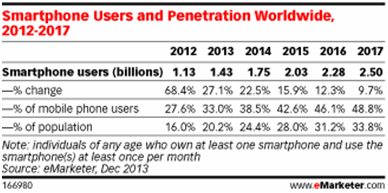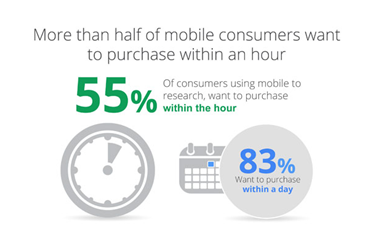Are you SEO Ready for Smartphones?
Mobile SEO Essentials
4.22 billion people worldwide are expected to use smartphones in 2014.
But, most marketers still don’t understand how powerful smartphones are when it comes to influencing online product/service purchase decisions. Here are some stats that are sure to raise a few eyebrows and can compel marketers to include mobile in their planning in 2014 and beyond.
Mobile Phone Users Worldwide (2012-2017)
According to a report in eMarketer, mobile phone adoption worldwide, seems to be slowing down. As western nations reach a saturation point, new users from developing regions such as Asia-Pacific, Middle East and Africa will continue to drive growth. Between 2014 and 2017, mobile phone penetration will rise from 63.5% to 69.4% of the worldwide population.

Mobile Phone Internet Users Worldwide (2012-2017)
It is expected that in 2014, 49% of the world’s mobile users will go online via mobile browsers or apps monthly. By 2015, it is anticipated that the global mobile phone internet audience will cross well over the 50% mark.

Smartphone Users and Penetration Worldwide (2012-2017)
Smartphone users surpassed the 1 billion mark globally in 2012 and this is projected to total 1.75 billion in 2014. A recent study by eMarketer reveals that 38.5% of mobile phone users will use a smartphone in 2014 and the usage is expected to reach one out of two mobile users by 2017. As devices become cheaper, users are quickly switching over to smartphones with 3G and 4G networks.

Mobile User Behavior
How exactly can you leverage the information we just provided?
Recently, Google certified Nielsen to conduct a study on the online purchase behavior of mobile users. The study revealed that 74% of mobile consumers use a search engine during the purchase process and 83% of mobile users intend to make a purchase within a day’s time.

With all these indications on how mobile phone usage is going to dominate online businesses, marketers need to channelize their SEO strategy to meet these expectations.
Before listing down the essentials for a successful mobile SEO strategy, we would like to point out that any mobile strategy that is developed should be directed to provide a better user experience and improve engagement on the website. It is important to remember the following points:
- Mobile Friendly Site
With the steep rise in online mobile traffic, a mobile friendly website is imperative in 2014 for a successful mobile SEO strategy. Companies need to invest in creating either a responsive or a dedicated mobile website. Once the website is created, marketers need to form a consolidated mobile SEO strategy along with desktop SEO, which remains as important.
- Mobile User Experience
User experience is the key to SEO. Over the last few years, search engines have been working to enhance user experience with mobile and provide improved results. Conversational and voice search are instances to look out for.
- Page Load Speed
Although this may seem to be intuitive, it is astonishing to see a number of companies give up on page load speed for an aesthetically pleasing image or video. Page load time immensely adds to the user experience, keeps user engagement high and improves conversions for the online business.
- Website Design – Focus on Usability
Usability of a website increases the probability to engage and convert users. Usability is important for mobile users as they have a small screen to view all the information. Essential elements like Call to Actions (CTAs) and relevant content should be built in for easy access to engage users and convert them on the website.
- Mobile User Intent
Google’s Hummingbird algorithm update in 2013 has said it all. The SEO community is still trying to understand the effects and how to deal with the update in real time.When a user searches for something on a desktop, the intent of that user may be very different from when he looks for similar information on his mobile device. There is a sense of urgency and more likely than not, an intent to purchase.According to the Google-Nielsen study:
- 55% of mobile users have an intention to purchase online within one hour
- 69% expect businesses to be present within 5 miles of their location
Hence, a smartphone user more often looks for local businesses near them and could have very high purchase intent.
- Conversational and Voice Search
Improve your local SEO with specific Keywords strategy for mobile users.Marketers need to understand the mobile users’ behavior pattern. Mentions of location with the target keyword will not be of any use when mobile users opt for voice search.For example, if a mobile user performs a voice search through their smartphone for a pizza joint or restaurant, they will probably ask “nearest restaurant location” rather than typing “restaurant + location”. Hence, including conversational search as a part of the SEO strategy will help in surpassing the competition.
- Fully Engage with Social Media – Social Integration
Mobile and social go hand in hand. Marketers should consider integrating both the channels – share social media buttons on mobile sites, create presence on social channels like Google+, Facebook, etc.Consumers utilize all mediums (devices) available to them to find information on products and services. A thoroughly formulated SEO strategy that will allow users to access information on product and services through all mediums will play a crucial role for success in 2014. So gear up EARLY! 2014 is set to be the year of Mobile Marketing!
Contributed by Rahul Banerjee, Head – SEO, Position² Inc.
Sources:



